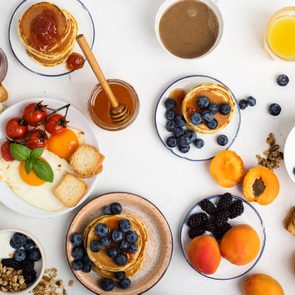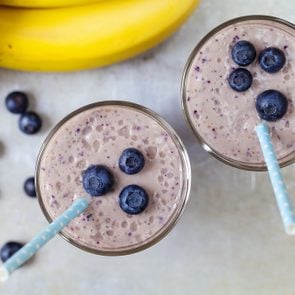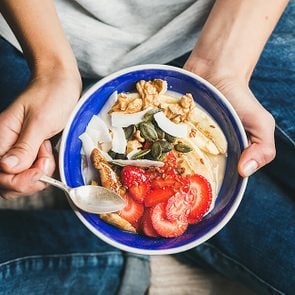5 Benefits of Eating Oatmeal for Breakfast
Updated: Jun. 04, 2021
Registered dietitian Cynthia Sass shares the health benefits of oatmeal, like weight management, and tips for preparing the healthiest bowl.
Americans are craving comfort foods big time. Your social media feed has likely been flooded with photos of homemade sourdough and banana bread, along with soothing dishes like mac and cheese. Grocery sales of long-standing staple foods have soared too, including oatmeal. The familiarity and heartiness of a warm bowl of oatmeal can feel consoling. But unlike many other foods in the comfort category, turning to oatmeal to appease your emotions can actually improve and protect your health. Here are five benefits of starting your day with this nutritious whole grain, and tips for further improving its healthfulness. (Find out exactly how bad it is to skip breakfast.)
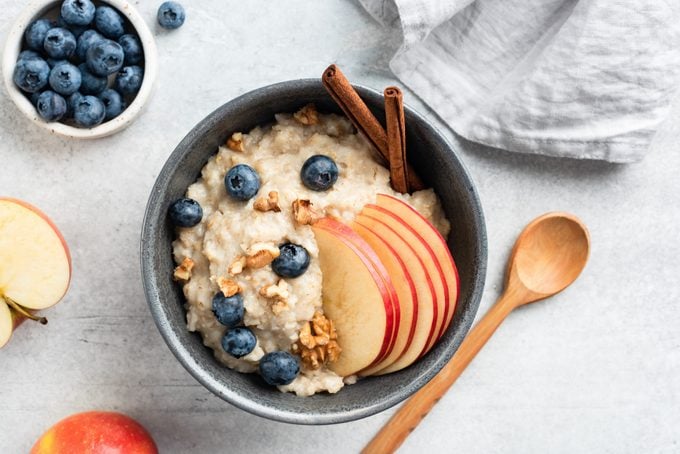
Oatmeal is rich in nutrients
A half-cup of dry oats contains 4 grams of filling fiber, 14 percent of the daily minimum target, in addition to 5 grams of plant protein. The grain’s carbohydrates are also bundled with a wide spectrum of vitamins and minerals, including iron, magnesium, zinc, selenium, B vitamins, and smaller amounts of calcium and potassium. That’s an impressive range for a single food that’s also affordable, simple to prepare, and versatile.
Oatmeal provides antioxidants
Oats deliver compounds called polyphenols that possess antioxidant and anti-inflammatory properties, according to a 2018 study in Food Research International. Polyphenols seem to reduce oxidative stress on the body—they help limit the activity of damaging molecules called free radicals. For this reason, polyphenols are linked to protection against heart disease and stroke, as well as type 2 diabetes and obesity, a 2017 study in Oxidative Medicine and Cellular Longevity suggests.
Oatmeal is a good fiber food
A type of fiber found in oats called beta-glucan has been shown to support healthy immune function, and reduce cholesterol and blood sugar concentrations, to lower the risk of heart disease and diabetes, according to a 2018 study published in the Polish journal Annals of the National Institute of Hygiene (). Beta-glucan also functions as an antioxidant, and in this role is tied to protection against hardening of the arteries, neurodegenerative diseases, such as Alzheimer’s, and cancer.
In a 2019 report, published in the Canadian Journal of Diabetes, researchers point to the use of oatmeal as a short-term dietary intervention associated with a significant reduction in blood sugar concentrations and improved insulin sensitivity in patients with type 2 diabetes. This benefit is at least partly due to beta-glucan, which suggests that oatmeal can help reduce and control blood sugar. (Learn more about the benefits of fiber.)
Beta-glucan also acts as a prebiotic, a substance that stimulates the growth of beneficial gut microbes, while also slowing or preventing the proliferation of harmful bacteria. As a fiber, beta-glucan assists your digestive tract and helps prevent gut inflammation.
Oatmeal supports healthy weight management
Starting your day with oatmeal can assist in controlling weight for a few reasons. Oatmeal promotes satiety, the feeling of fullness that persists after eating. In a 2016 study, published in the journal Appetite, researchers fed volunteers equal amounts of oranges and oatmeal. After eating oranges, people reported feeling hungrier and less satisfied than they did after a bowl of oatmeal. Those feelings of fullness can support a healthy weight by naturally curbing consumption later in the day. In this particular study, volunteers ate less food when allowed to freely snack a few hours after eating the oatmeal compared with the oranges. (Try these breakfast ideas for any weight loss plan.)
As a whole grain, oatmeal assists weight control by supporting your metabolism. When you eat whole grains, you get the bran and germ parts of the grain; with refined grains, these nutritious parts are stripped away and you miss out on fiber and key nutrients. In a 2017 study published in the American Journal of Clinical Nutrition, healthy men and postmenopausal women were randomly assigned to weight maintenance diets that all had the same number of calories but had different levels of whole grains and fiber. Researchers found that after six weeks, resting metabolic rate, a measure of the calories you burn when you’re not active, increased only in people getting plenty of whole grains.
These outcomes may be why a 2015 study, published in the journal Nutrition Research, concluded that regular oatmeal eaters had lower body weights, smaller waist circumferences, and lower body mass indices (BMI—a number that reflects a combination of a person’s weight and height)). They also scored higher on the Healthy Eating Index, a measure of overall diet quality.
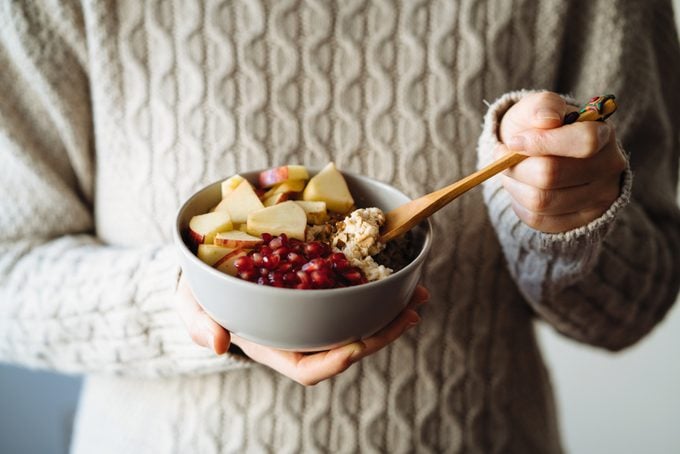
Oatmeal protects overall health
According to the Centers for Disease Control and Prevention (CDC), heart disease remains the number one killer of both men and women in the United States, with one person dying every 37 seconds from cardiovascular disease. A 2019 review of research published in the European Journal of Preventive Cardiology revealed that oatmeal may lower the risk of not only heart disease but all causes of death. Researchers analyzed 16 studies to find whether a diet that emphasized certain healthy foods might add years to a person’s life; they also looked at 17 studies to see how food might protect against cardiovascular disease. Scientists found that whole grain consumption, including specifically oatmeal for breakfast, was tied to a lower risk of death from all causes, including heart disease.
How to make oatmeal even healthier
One way to undermine the benefits of oatmeal is to load it up with lots of refined sugar—but eating oats plain isn’t for everyone. As a registered dietitian, I’m often asked how one should start the day with oats as the foundation. I have a few go-to suggestions.
Savory oats
Most people think of topping oats with something on the sweet side, but the grain shines in a savory setting as well: Try combining a half cup of oats with hot water and top them with a generous portion—at least double the oats—of non-starchy vegetables, such as kale, red bell peppers, onions, and mushrooms, lightly sautéed in extra virgin olive oil with garlic and herbs. For protein, add a cooked egg or a scoop of beans or lentils along with sliced avocado or olives for bonus healthful fat.
Sweet oats
If you prefer sweet, you can enjoy your oats hot or chilled. To boost the protein, I recommend mixing a half cup of dry old fashioned rolled oats with a quarter cup of a plain, unsweetened plant protein powder, such as pea, brown rice, or chickpea protein. Add hot water and stir to dissolve the protein. Fold in a teaspoon or two of pure maple syrup to sweeten, along with a spice of your choice, like ground cinnamon or freshly grated ginger. Stir in a scoop of finely chopped veggies, like riced cauliflower or shredded zucchini. Top with a bit of fresh fruit, and garnish with a quarter cup of chopped nuts or seeds or a drizzle of nut or seed butter. Enjoy warm or refrigerate overnight and eat chilled the following morning. Here’s how to make overnight oats.
Oatmeal combinations
These combinations help you fill your daily veggie quota, increase the overall fiber content, balance the macronutrient ratios, and provide an even broader spectrum of vitamins, minerals, and antioxidants. For other creative ways to fuel your morning, blend rolled oats into a protein-and-produce packed smoothie, whip up a batch of oatmeal breakfast cookies or homemade oat bars, or layer lightly toasted oats parfait style with fruit, nuts, and a plant-based yogurt. The old saying ‘breakfast is the most important meal of the day’ is even more true when your starter meal includes whole foods with functional benefits, and oatmeal is a superior option! (Also, try out these healthy breakfast recipes.)


















